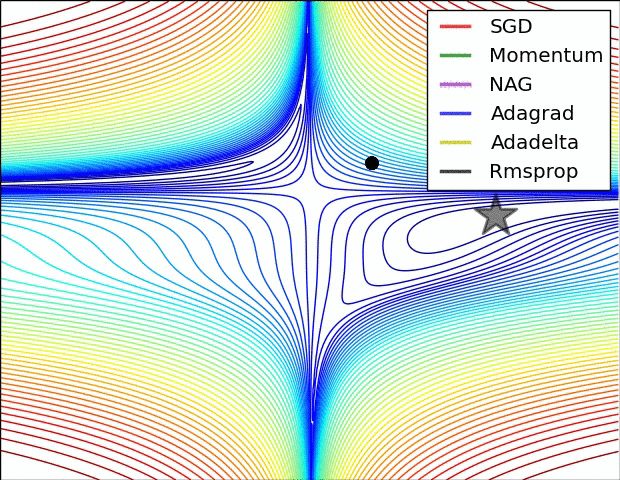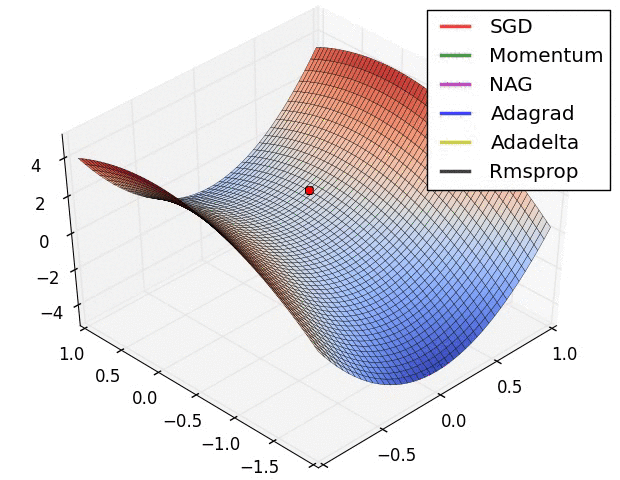Gradient Descent
Suppose a man is at top of the valley and he wants to get to the bottom of the valley. So he goes down the slope.
He decides his next position based on his current position and stops when he gets to the bottom of the valley which was his goal.
The Idea
The Idea

Take repeated steps in the opposite direction of the gradient of the function at the current point.
The Idea
Gradient descent is a first-order iterative optimization algorithm for finding a local minimum of a differentiable function.
Formal Definition
It performs two steps iteratively:
- Compute the slope (gradient) that is the first-order derivative of the function at the current point
- Move-in the opposite direction of the slope increase from the current point by the computed amount
The Algorithm
Consider some continuously differentiable real-valued function \(f: \mathbb{R} \rightarrow \mathbb{R}\).
Using a Taylor expansion we obtain
$$f(x + \epsilon) = f(x) + \epsilon f'(x) + \mathcal{O}(\epsilon^2).$$
Pick a fixed step size \(\eta > 0\), and choose \(\epsilon = -\eta f'(x)\):
$$f(x - \eta f'(x)) = f(x) - \eta f'^2(x) + \mathcal{O}(\eta^2 f'^2(x)).$$
Mathematical Formulation
If \(f'(x) \neq 0\), with a small enough \(\eta\) we have:
$$f(x - \eta f'(x)) \lessapprox f(x).$$
This means that, if we use
$$x \leftarrow x - \eta f'(x)$$
to iterate \(x\), the value of function \(f\) might decline.
Mathematical Formulation
Repeat the iterations until
- At most \(N\) iterations.
- When magnitude of the gradient \(|f'(x)|\) is small enough
- When the function converged \(|f(x_{n+1}) - f(x_n)| < \xi\)
Stopping Criteria
Implementation
import numpy as np
def f(x):
return x**2
def df(x):
return 2 * x
a, b = -10, 20 # optimization domain
eta = 0.05 # learning rate
max_iterations = 53
x = 18 # x_initial
history = [x] # save function values
for epoch in range(max_iterations):
x = x - eta * df(x) # x = x - eta * df/dx
history.append(x)
print('final x =', x)Visualization

Step Size

Step Size
If we use an excessively high learning rate, \(\mathcal{O}(\eta^2 f'^2(x))\) might become significant. Hence we cannot guarantee that the iteration of \(x\) will be able to lower the value of \(f(x)\).

Local Minimum

Multivariate Gradient Descent
Suppose \(\mathbf{x} = [x_1, x_2, \ldots, x_d]^\top\) and objective function \(f: \mathbb{R}^d \to \mathbb{R}\). The gradient will be defined as:
$$\nabla f(\mathbf{x}) = \bigg[\frac{\partial f(\mathbf{x})}{\partial x_1}, \frac{\partial f(\mathbf{x})}{\partial x_2}, \ldots, \frac{\partial f(\mathbf{x})}{\partial x_d}\bigg]^\top.$$
Here the Taylor approximation takes the form
$$f(\mathbf{x} + \boldsymbol{\epsilon}) = f(\mathbf{x}) + \mathbf{\boldsymbol{\epsilon}}^\top \nabla f(\mathbf{x}) + \mathcal{O}(\|\boldsymbol{\epsilon}\|^2).$$
The corresponding gradient descent iteration:
$$\mathbf{x} \leftarrow \mathbf{x} - \eta \nabla f(\mathbf{x}).$$
In Machine Learning
Many of the machine learning models use gradient descent on their core:
- Perceptron algorithm
- Linear & Logistic Regression
- Ridge, Lasso & Elastic Net Regression/Classification
- Neural Networks & Deep Learning
Types of Gradient Descent
- Batch gradient descent
- Stochastic gradient descent
- Mini-batch gradient descent
Batch Gradient Descent
Vanilla gradient descent, aka batch gradient descent, computes the gradient of the cost function w.r.t. to the parameters \(\theta\) for the entire training dataset
$$\theta = \theta - \eta \cdot \nabla_\theta J( \theta)$$
for i in range(n_epochs):
params_grad = evaluate_gradient(loss_function, data, params)
params = params - learning_rate * params_gradBATCH GRADIENT DESCENT
- Takes the average of the gradients of all the training examples for updating parameters.
- Just one step of gradient descent in one epoch.
- It is great for convex or relatively smooth error manifolds.
- It can be very slow and is intractable for datasets that don't fit in memory.
Stochastic Gradient Descent
Stochastic gradient descent (SGD) in contrast performs a parameter update for each training example \(x^{(i)}\) and label \(y^{(i)}\):
$$\theta = \theta - \eta \cdot \nabla_\theta J( \theta; x^{(i)}; y^{(i)})$$
for i in range(nb_epochs):
np.random.shuffle(data)
for example in data:
params_grad = evaluate_gradient(loss_function, example, params)
params = params - learning_rate * params_gradSTOCHASTIC GRADIENT DESCENT
- It is usually much faster and can also be used to learn online.
- It converges faster when the dataset is large
- It performs frequent updates with a high variance that cause the objective function to fluctuate heavily.
- SGD's fluctuation, enables it to jump to new and potentially better local minima.
Mini-Batch Gradient Descent
Mini-batch gradient descent finally takes the best of both worlds and performs an update for every mini-batch of \(n\) training examples:
$$\theta = \theta - \eta \cdot \nabla_\theta J( \theta; x^{(i:i+n)}; y^{(i:i+n)})$$
for i in range(nb_epochs):
np.random.shuffle(data)
for batch in get_batches(data, batch_size=50):
params_grad = evaluate_gradient(loss_function, batch, params)
params = params - learning_rate * params_gradMINI-BATCH GRADIENT DESCENT
- It reduces the variance of the parameter updates, which can lead to more stable convergence
- it can make use of highly optimized vectorized optimizations
Challenges
Choosing a proper learning rate can be difficult. A learning rate that is too small leads to painfully slow convergence, while a learning rate that is too large can hinder convergence and cause the loss function to fluctuate around the minimum or even to diverge.
Challenges
Learning rate schedules try to adjust the learning rate during training by e.g. annealing, i.e. reducing the learning rate according to a pre-defined schedule or when the change in objective between epochs falls below a threshold. These schedules and thresholds, however, have to be defined in advance and are thus unable to adapt to a dataset's characteristics.
Challenges
Additionally, the same learning rate applies to all parameter updates. If our data is sparse and our features have very different frequencies, we might not want to update all of them to the same extent, but perform a larger update for rarely occurring features.
Advanced Methods
- Momentum
- Nesterov
- Adagrad
- Adadelta
- RMSprop
- Adam
- AMSGrad
- AdamW
- QHAdam
- AggMo
Comparison of Methods


Resources
- https://d2l.ai/chapter_optimization/gd.html
- https://ruder.io/optimizing-gradient-descent/
- https://towardsdatascience.com/batch-mini-batch-stochastic-gradient-descent-7a62ecba642a
- https://raghumeka.github.io/CS289ML/gdnotes.pdf